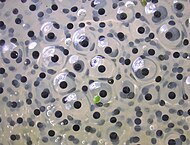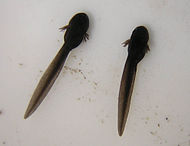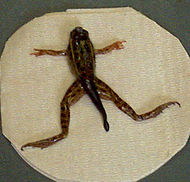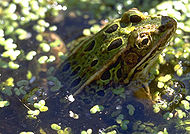|
|
| (828 intermediate revisions by more than 100 users not shown) |
| Line 1: |
Line 1: |
| − | {{alternateuses}}
| + | <noinclude><translate></noinclude> |
| − | {{Taxobox_begin | color = pink | name = True Frogs}}
| + | ===Frogs=== <!--T:1--> |
| − | {{Taxobox_image | image = [[image:Americanfrog.jpg|200px|A frog]] | caption = }}
| + | [[Image:Frogspawn closeup.jpg|190px|thumb|Frogspawn]] |
| − | {{Taxobox_begin_placement | color = pink}}
| + | [[Image:Tadpoles 10 days.jpg|190px|thumb||10 days: Tadpoles]] |
| − | {{Taxobox_regnum_entry | taxon = [[Animal|Animalia]]}}
| + | [[Image:Frog-Zhe.jpg||190px|thumb|8–12 weeks: Froglet]] |
| − | {{Taxobox_phylum_entry | taxon = [[Chordate|Chordata]]}}
| + | [[Image:Green-leopard-frog-in-swamp.jpg||190px|thumb|12–16 weeks: Adult frog]] |
| − | {{Taxobox_classis_entry | taxon = [[Amphibia]]}}
| + | The life cycle of frogs, like that of other amphibians, consists of four main stages: egg, tadpole, metamorphosis and adult. The reliance of frogs on an aquatic environment for the egg and tadpole stages gives rise to a variety of breeding behaviors that include the well-known mating calls used by the males of most species to attract females to the bodies of water that they have chosen for breeding. Some frogs also look after their eggs—and in some cases even the tadpoles—for some time after laying. |
| − | {{Taxobox_ordo_entry | taxon = [[Anura]]}}
| |
| − | {{Taxobox_familia_entry | taxon = '''Ranidae'''}}
| |
| − | {{Taxobox_end_placement}}
| |
| − | {{Taxobox_section_subdivision | color = pink | plural_taxon = Genera}}
| |
| − | See text.
| |
| − | {{Taxobox_end}}
| |
| − | '''Frogs''' are [[Amphibia|amphibians]] of the [[family (biology)|family]] '''Ranidae''', in the [[order (biology)|Order]] [[Anura]]. They are closely related to [[toad]]s. The Ranidae are sometimes called the "true frogs" since a few members of other families also have common names including the word "frog."
| |
| | | | |
| − | ==Types and characteristics of frogs==
| + | <!--T:2--> |
| − | Frogs are a diverse group with some 4800 [[species]]. Most spend their lives in or near a source of water (''water frogs''), although ''tree frogs'' live in moist environments that are not actually aquatic. The requirement for water becomes most acute for egg and tadpole stages of the frog, yet here again some species are able to utilize temporary pools and water collected in the axils of [[plants]].
| + | The life cycle of a frog starts with an egg. Eggs are generally laid in water, and an individual female may lay egg masses containing thousands of eggs. While the length of the egg stage depends on the species and environmental conditions, aquatic eggs generally hatch within one week. |
| | | | |
| − | The most familiar frogs are [[Common frog]]s, [[Bullfrog]]s, [[Edible frog]]s, [[Leopard frog]]s, [[Spring Peeper]]s, [[Poison dart frog]]s, and [[Green Frog]]s.
| + | <!--T:3--> |
| | + | Some frogs do not have the tadpole stage going from egg to adult shape e.g. New Zealand's native frogs (pepeketua) belong to the genus Leiopelma. |
| | + | Eggs hatch and continue life as tadpoles (occasionally known as polliwogs). Tadpoles are aquatic, lack front and hind legs, and have gills for breathing and tails with fins for swimming. Tadpoles are typically herbivorous, feeding mostly on algae, including diatoms that are filtered from the water through the gills. Some species are carnivorous at the tadpole stage, eating insects, smaller tadpoles and fish. The tadpole stage may be as short as a week, or tadpoles may overwinter and metamorphosis the following year in some species, such as the Midwife toad (''Alytes obstetricans'') and the Common Spadefoot (''Pelobates fuscus''). |
| | | | |
| − | [[Image:Tiny little frog.jpg|left|thumb|Some adult frogs are smaller than a person's thumb.]]
| + | <!--T:4--> |
| − | Frogs range in size from less than 50mm (2.0 in) to 300mm (11.8 in) in ''Conraua goliath'', which is the largest known frog. All frogs have horizontal [[pupil]]s, smooth skin and long legs with webbing between their toes. This family has a [[bicornuated tongue]] that is attached in front: They also have a [[tympanum]] on each side of their head, which is involved in hearing. Most frogs have deep, booming calls, or '''croaks''', with some being onomatopoeically represented by the sound (for English speakers), "'''ribbet'''" or "'''ribbit'''." The [[Ancient Greeks]], via [[Aristophanes]], transcribed the sound of a croaking frog as, "korax."
| + | At the end of the tadpole stage, frogs undergo metamorphosis, in which they transition into adult form. Metamorphosis involves a dramatic transformation of body shape and function, as tadpoles develop hind legs and then front legs, lose their gills and develop lungs. Their intestines shorten as they shift from an herbivorous to a carnivorous diet. The final stage of development from froglet to adult frog involves the loss of the tail. |
| | | | |
| − | Many species of frog secrete [[toxin]]s from their skin. These toxins deter predatory animals from eating them, and some are extremely poisonous to humans. The natives of the [[Amazon_Rainforest|Amazon]] area extract arrow-poison from the arrow-poison frog. Almost all [[toad]]s have two lumps near the head. These lumps contain poison, which is oozes out if the toad is angered. Some, like [[cane toads]], are more poisonus than others.
| + | <!--T:5--> |
| − | | + | After metamorphosis, young adults may leave the water and disperse into terrestrial habitats, or continue to live in the aquatic habitat as adults. Almost all species of frogs are carnivores as adults, eating invertebrates such as spiders, insects, snails, and slugs. A few of the larger species may eat prey such as small mammals, fish and smaller frogs. Some frogs use their sticky tongues to catch fast-moving prey, while others capture their prey and force it into their mouths with their hands. However, there are a very few species of frogs that primarily eat plants. Adult frogs are themselves preyed upon by birds, large fish, snakes, otters, foxes, badgers, coatis, and other animals. |
| − | ==Distribution and Status==
| + | <br style="clear:both"> |
| − | [[Image:Frog.jpg|thumb|left|Australian Frog]]
| + | <noinclude></translate></noinclude> |
| − | Members of this family are found worldwide, but they have a limited distribution in [[South America]] and [[Australia]]. They do not occur in the [[West Indies]], nor on most oceanic islands.
| + | [[Category:Adventist Youth Honors Answer Book|{{SUBPAGENAME}}]] |
| − | | |
| − | In many parts of the world the frog population has [[Decline in frog populations|declined]] drastically over the last few decades. Pollutants are one cause for this decline, but other culprits include climatic changes, parasitic infestation, introduction of non-indigenous predators/competitors, infectious diseases, and urban encroachment.
| |
| − | | |
| − | ==Life cycle==
| |
| − | {| align=right
| |
| − | |[[Image:Frogspawn closeup.JPG|thumb|Frogspawn]]
| |
| − | |[[image:Tadpoles 10 days.JPG|thumb|The tadpoles, ten days later]]
| |
| − | |-
| |
| − | |[[Image:Frog-Zhe.jpg|thumb|Froglet]]
| |
| − | |[[image:Green-leopard-frog-in-swamp.jpg|thumb|right|Adult frog]]
| |
| − | |}
| |
| − | | |
| − | The life cycle of a frog involves several stages. Typically adult frogs gather in suitable pools, the first to arive usually being the males. Their croaking may well encourage the females to arrive. A female would wish to avoid arriving at a pond which did not have any males in attendance. Gravid female frogs are actively and persistently sought out by males and many males will often try to attach themselves to a single female but eventually one male will secure possession. [[Amplexus]] is the process wherein the male grasps the female while she lays her eggs. At the same time, he fertilizes them with a fluid containing sperm. The eggs are about 2.0 to 2.8 millimetres in diameter and are dark brown and are covered in an outer shell of gelatinous transparent material which swells in contact with water. The female frog lays her [[Egg (biology)|egg]]s in a shallow [[pond]] or creek, where they will be sheltered from the current and from predators. The eggs, known as ''frogspawn'' hatch into [[tadpole]]s. The tadpole stage develops gradually into a [[froglet]], resembling an adult but retaining a vestigial tail. Finally the froglet develops into an adult frog. Typically, tadpoles are [[herbivore]]s, feeding mostly on [[alga]]e, whereas juvenile and adult frogs are rather voracious [[carnivore]]s.
| |
| − | | |
| − | Most temperate species of frog reproduce in the period between late autumn to early spring. In the [[UK]] most Common Frog populations produce frogspawn in February although there is wide variation in timing. Water temperatures at this time of year are relatively low and typically between four and 10 degrees celsius. Reproducing in these conditions helps the developing tadpoles because dissolved oxygen concentrations in the water are highest at cold temperatures. More importantly, reproducing early in the season ensures that appropriate food is available to the developing frogs at the right time.
| |
| − |
| |
| − | ==Diet==
| |
| − | | |
| − | Most frogs eat [[insect]]s such as [[mosquito]]es, and small fish such as [[minnow]]s; however, a few of the bigger ones may tackle larger prey, such as [[mice]]. Their sticky tongues are effective in catching fast-moving prey. They hunt mostly at night.
| |
| − | | |
| − | ==A new frog==
| |
| − | | |
| − | ''Main article: [[Purple Frog]]''
| |
| − | | |
| − | In 2003, Franky Bossuyt of the ''[[Vrije Universiteit Brussel]]'' (Free University of Brussels) and S.D. Biji of the Tropical Botanic Garden and Research Institute in [[Palode]], [[India]] reported the discovery of a new [[species]] of frog so distinct in appearance and [[DNA]] that it merited its own new [[Scientific classification|family]], the first new family for frogs since [[1926]]. This new species, dubbed ''[[Purple Frog|Nasikabatrachus sahyadrensis]]'' (commonly ''Purple Frog'' or ''Pignose Frog''), is dark purple in color, seven centimeters in length, and has a small head and a pointy snout. Genetically, its closest living relatives are the [[sooglossid]]s found in the [[Seychelles]]. The new species was discovered in the [[Sahyadri]] (Western Ghats) Mountains in India.
| |
| − | | |
| − | * [http://news.bbc.co.uk/1/hi/sci/tech/3200214.stm BBC article with photos of the Purple Frog]
| |
| − | | |
| − | ==Frogs in popular culture==
| |
| − | | |
| − | *One of the most famous frogs in the entertainment world is the [[Muppet]] character [[Kermit the Frog]].
| |
| − | *The American TV network The WB ([[Warner Brothers]]) uses Michigan J. Frog, a frog in a tuxedo as their logo. Michigan J. Frog was the singing, dancing star of the [[1955]] Warner cartoon, "[[One Froggy Evening]]".
| |
| − | *''[[Frogger]]'' is an early electronic [[arcade game]], with a frog trying to cross a busy road and river.
| |
| − | *Frogs fall from the sky in various urban myths and notably in the movie [[Magnolia]].
| |
| − | *The behavior of frogs illustrating nonaction is a myth. ("Take a pot of hot water and a frog. Throw the frog into the pot. What do you think will happen? The obvious, of course: the frog will jump out. Who likes hanging around in a pot of hot water? Now ... [t]ake a pot of cold water, put the frog in it, and place the pot on the stove. Turn on the heat. This time something different will occur. The frog, because of the incremental change in temperature, will not notice that it is slowly being boiled." from "Life and Death in the Executive Fast Lane" by Manfred Kets de Vries) Professor Doug Melton, Harvard University Biology Department, says, "If you put a frog in boiling water, it won't jump out. It will die. If you put it in cold water, it will jump before it gets hot -- they don't sit still for you." [http://www.fastcompany.com/online/01/frog.html] A frog put anywhere that doesn't kill it will jump, "they don't sit still for you."
| |
| − | | |
| − | ==External links== | |
| − | * [http://www-itg.lbl.gov/ITG.hm.pg.docs/Whole.Frog/Whole.Frog.html The Whole Frog Project] ~ (virtual frog dissection and anatomy)
| |
| − | * ''[http://raysweb.net/specialplaces/pages/frogsdecline.html Disappearance of toads, frogs has some scientists worried]'' ~ ''San Francisco Chronicle'', April 20, 1992
| |
| − | * [http://www.frogsonice.com/froggy/ The Froggy Page] ~ Frog fun
| |
| − | * [http://www.dartden.com Dart Den] ~ Dart frog resource and forums
| |
| − | * [http://www.xenbase.org/ Xenbase] ~ A <i>Xenopus laevis</i> and <i>tropicalis</i> Web Resource
| |
| − | *[[Category:Frogs]]
| |
| − | | |
| − | [[ast:Xaronca]]
| |
| − | [[da:Frø (padde)]]
| |
| − | [[de:Froschlurche]]
| |
| − | [[es:Rana]]
| |
| − | [[fr:Grenouille]]
| |
| − | [[nl:Kikker]]
| |
| − | [[ja:カエル]]
| |
| − | [[pl:żaba]]
| |
| − | [[pt:Sapo]]
| |
| − | [[simple:frog]]
| |
Frogs
The life cycle of frogs, like that of other amphibians, consists of four main stages: egg, tadpole, metamorphosis and adult. The reliance of frogs on an aquatic environment for the egg and tadpole stages gives rise to a variety of breeding behaviors that include the well-known mating calls used by the males of most species to attract females to the bodies of water that they have chosen for breeding. Some frogs also look after their eggs—and in some cases even the tadpoles—for some time after laying.
The life cycle of a frog starts with an egg. Eggs are generally laid in water, and an individual female may lay egg masses containing thousands of eggs. While the length of the egg stage depends on the species and environmental conditions, aquatic eggs generally hatch within one week.
Some frogs do not have the tadpole stage going from egg to adult shape e.g. New Zealand's native frogs (pepeketua) belong to the genus Leiopelma.
Eggs hatch and continue life as tadpoles (occasionally known as polliwogs). Tadpoles are aquatic, lack front and hind legs, and have gills for breathing and tails with fins for swimming. Tadpoles are typically herbivorous, feeding mostly on algae, including diatoms that are filtered from the water through the gills. Some species are carnivorous at the tadpole stage, eating insects, smaller tadpoles and fish. The tadpole stage may be as short as a week, or tadpoles may overwinter and metamorphosis the following year in some species, such as the Midwife toad (Alytes obstetricans) and the Common Spadefoot (Pelobates fuscus).
At the end of the tadpole stage, frogs undergo metamorphosis, in which they transition into adult form. Metamorphosis involves a dramatic transformation of body shape and function, as tadpoles develop hind legs and then front legs, lose their gills and develop lungs. Their intestines shorten as they shift from an herbivorous to a carnivorous diet. The final stage of development from froglet to adult frog involves the loss of the tail.
After metamorphosis, young adults may leave the water and disperse into terrestrial habitats, or continue to live in the aquatic habitat as adults. Almost all species of frogs are carnivores as adults, eating invertebrates such as spiders, insects, snails, and slugs. A few of the larger species may eat prey such as small mammals, fish and smaller frogs. Some frogs use their sticky tongues to catch fast-moving prey, while others capture their prey and force it into their mouths with their hands. However, there are a very few species of frogs that primarily eat plants. Adult frogs are themselves preyed upon by birds, large fish, snakes, otters, foxes, badgers, coatis, and other animals.




